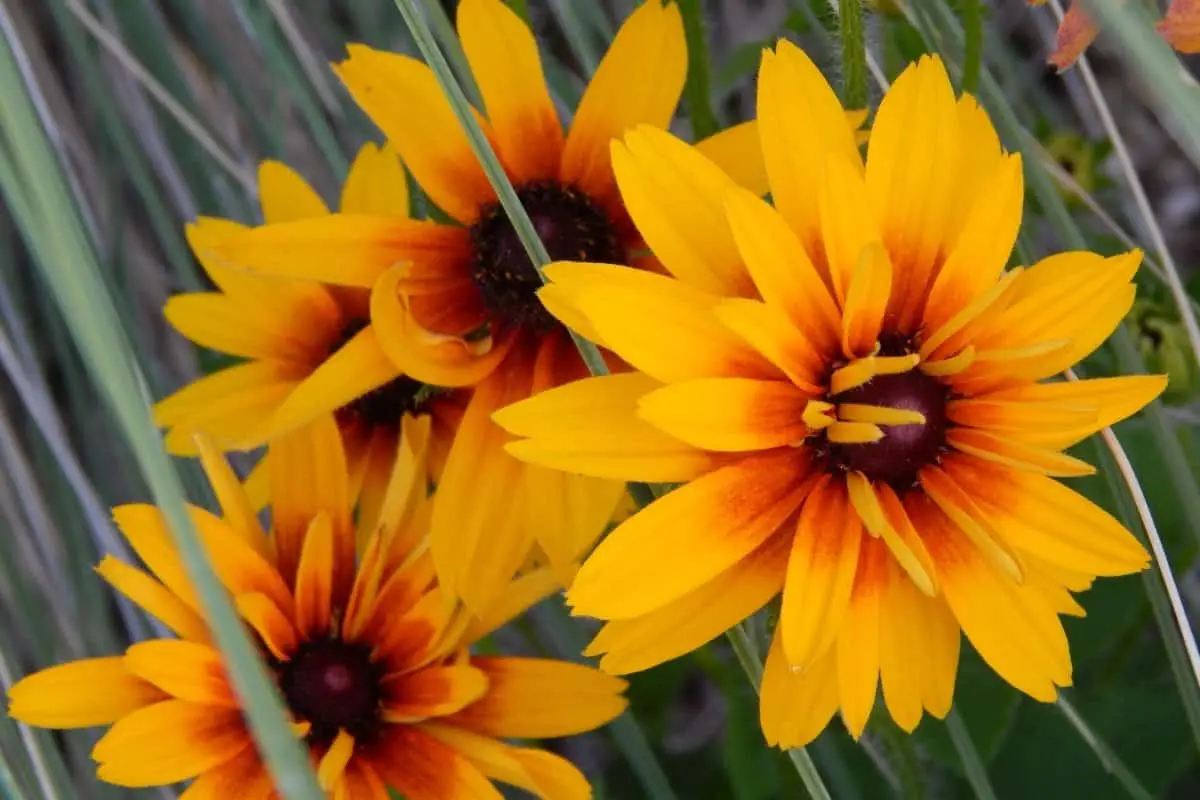Last Updated on January 20, 2022 by
Do you know when to plant black-eyed Susans (Rudbeckia )according to the climate of your region or do you allow them to grow wildly?
There is a reason why every garden has these cheerful yellow flowers blossoming. They are hard to beat with their easy maintenance and big bloom power.
They are also a great addition to your garden to facilitate pollination and attract butterflies, hummingbirds, and bees.
Although these flowers have often been dismissed as common wildflowers, they are garden plants that won the plant of the year in 2008. This well-deserved accolade led to the development of an impressive array of these garden cultivars for the National Garden Bureau.
The new generation species offer greater flair and versatility making them sustainable for most types of gardens.
When Is The Right Time To Plant Black-Eyed Susans Seeds?
Black-eyed Susans, a member of the sunflower family (Asteraceae) and similar to daisy-like flowers are ready for planting in the spring or early fall. Allow them a chance to establish roots before the weather gets extremely hot or cold. Once they have their roots in place, they will be fine to continue growing with less maintenance.
They grow in zones 3 through 9. They have a long bloom period even without deadheading from late July to the first frost. Some varieties have extended bloom times and begin flowering in mid to late spring.
Where Do You Plant Black Eyed Susans?
- Full Sun. Black-eyed Susans do well in full sun, at least 6 to 8 hours per day. Some varieties love some shade too but too much shade makes them stretch towards the light.
- A Visible Area. Plant these flowers where you don’t mind seeing them as often as possible. They do well as annuals or perennials and they are great re-seeders.
- Allow Height to Develop. When choosing where to grow them, choose an area that they can grow tall without any interference. Different varieties of black-eyed Susans mature to different heights. Some grow up to 18 inches while others can be 4 or even 6 feet tall.
- Soil. These flowers tolerate a wide range of soils including clay, loam, and sandy. Add organic matter to sandy soil to help it retain moisture. If you have good water retaining soils, choose the Sweet Black-eyed Susan variety. It does best in these kinds of soils.
- Spacing. Plant your flowers at least 18 inches apart. They will need the space to grow wide and tall.
Growing Black-Eyed Throughout The Season
Growth Habit. Rudbeckias are compact growing plants that grow about 2 inches wide. The height varies with each variety but most are less than 3 feet high. They are either annuals or biennials.
Watering. This flower tolerates dry soil for a few weeks. However, be sure to water weekly if you are experiencing a prolonged drought and the plants are showing signs of stress.

Fertilizing. Use some light fertilizer during springtime or before they bloom to give them more nutrients.
Pruning. Dead-heading will prolong blooming and reduce self-seeding. You may also leave the seed heads intact as winter bird food.
How To Choose Black-Eyed Susans
If you choose to grow perennials, plant the Rudbeckia fulgida. The annual variety commonly growing on the roadside is the Rudbeckia hirta. Black-eyed Susans are both perennial and annuals. Your choice depends on when you want your flowers to bloom and how long.
If you want the type that comes back year after year, go for the perennial type. Be sure to check the genus name on the plant tag to ensure you buy the right type.
End Of The Season Care
During winter these flowers will stop growing and resume after the frost season is over. The end of season care includes
Cutting the Stalks. After winter, cut all the remaining stalks to the ground either in fall or spring for a fresh start of a new season.
VIOSUN 6.5 Inch Gardening Hand Pruner
Dividing and Transplanting. These flowers benefit greatly from dividing every 3 to 5 years. Any varieties designated as short-lived perennial must not be divided, they should be left undisturbed.
Also, learn How To Plant Gladiolus and When To Plant Gladiolus
FAQs
Can you start Black Eyed Susans from seed?
Yes, but it’s not the easiest thing to do. I’ve had good success with this method, but it’s not a sure thing. There are many variables that affect the seed germination process and most of these are out of your control.
The main variable is the type of seed. Some seeds require a lot of warmth and some need lots of cold. Some seeds need moist soil and others don’t like wet soil at all. Some seeds need light and some can go for months without it.
When Should black-eyed Susan seeds be planted?
I sowed my seeds in May and did not have any problems with the first plants. I put the seedlings out on the east side of my house. In August, I transplanted them into their permanent positions, and they are doing very well. They have been there for over a month now, and everything is growing and thriving.
How deep do you plant Black Eyed Susan seeds?
The depth of planting depends on the type of soil. When planting in clay, mix a bit of peat moss into the potting soil and keep the soil moist until the seedlings are large enough to handle. Then, water the seedlings regularly. For planting in sand, use the same amount of peat moss as in clay. You can also try planting the seeds directly into the sand.
Do black eyed Susan vines reseed?
Yes, they do. They're a perennial vine. You can see some of the white berries on the top photo. The black ones are smaller and more likely to fall off and not reappear in the next year's harvest. But you can always try. If they don't come back, you'll need to remove them.
Will black-eyed Susans grow in pots?
It’s a question many gardeners ask when they start looking for a plant to put out on their patio or deck. Black-eyed Susans are among the best plants for growing in containers. They can be started from seed indoors about eight weeks before your last frost date and then transplanted outside. They grow very quickly, reaching a height of 6 feet by summer’s end.
What is some basic information about Black-Eyed Susans??
Black-eyed Susan is a perennial that grows easily from seed. It has long, narrow leaves and blooms in late spring. The flower petals are lavender, purple, or white and the flowers are surrounded by a fluffy cloud of seeds that look like a little black-eyed Susan. The seeds are dispersed by birds and other animals. Black-eyed Susans are native to North America.
Conclusion
FAQs
Can you start Black Eyed Susans from seed?
Yes, but it’s not the easiest thing to do. I’ve had good success with this method, but it’s not a sure thing. There are many variables that affect the seed germination process and most of these are out of your control.
The main variable is the type of seed. Some seeds require a lot of warmth and some need lots of cold. Some seeds need moist soil and others don’t like wet soil at all. Some seeds need light and some can go for months without it.
When Should black-eyed Susan seeds be planted?
I sowed my seeds in May and did not have any problems with the first plants. I put the seedlings out on the east side of my house. In August, I transplanted them into their permanent positions, and they are doing very well. They have been there for over a month now, and everything is growing and thriving.
How deep do you plant Black Eyed Susan seeds?
The depth of planting depends on the type of soil. When planting in clay, mix a bit of peat moss into the potting soil and keep the soil moist until the seedlings are large enough to handle. Then, water the seedlings regularly. For planting in sand, use the same amount of peat moss as in clay. You can also try planting the seeds directly into the sand.
Do black eyed Susan vines reseed?
Yes, they do. They're a perennial vine. You can see some of the white berries on the top photo. The black ones are smaller and more likely to fall off and not reappear in the next year's harvest. But you can always try. If they don't come back, you'll need to remove them.
Will black-eyed Susans grow in pots?
It’s a question many gardeners ask when they start looking for a plant to put out on their patio or deck. Black-eyed Susans are among the best plants for growing in containers. They can be started from seed indoors about eight weeks before your last frost date and then transplanted outside. They grow very quickly, reaching a height of 6 feet by summer’s end.
What is some basic information about Black-Eyed Susans??
Black-eyed Susan is a perennial that grows easily from seed. It has long, narrow leaves and blooms in late spring. The flower petals are lavender, purple, or white and the flowers are surrounded by a fluffy cloud of seeds that look like a little black-eyed Susan. The seeds are dispersed by birds and other animals. Black-eyed Susans are native to North America.
When you plant black-eyed Susans at the right time, you will enjoy their full bloom before the frost sets in. Every plant thrives best if you plant it at the right time and especially if it cannot withstand winter. It will bloom at the right time!
Most plants bloom during the spring and summer when the weather is all bright and beautiful. We also brighten up our homes with these beauties during summer with time to make merry and enjoy the simple joys of life.
Caroline is a gardener who loves to get down to the nitty–gritty of gardening. She proudly proclaims herself as a ‘dirt worshipper‘ and can often be found deep in the garden, covered in soil and singing to her plants. As a self–proclaimed ‘plant whisperer‘, Caroline believes that plants need love and attention just like any other living thing, and she loves to give them both. When she‘s not tending to her garden, you can often find her researching the latest gardening trends, or teaching others how to make their gardens thrive



